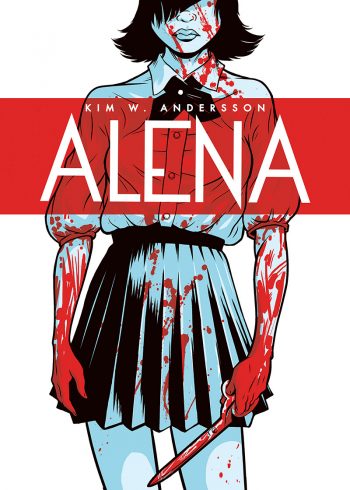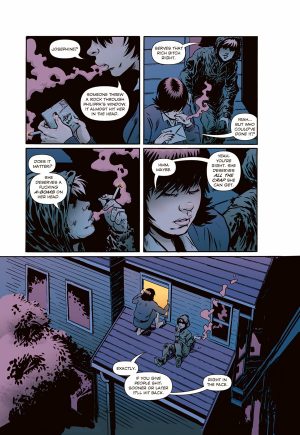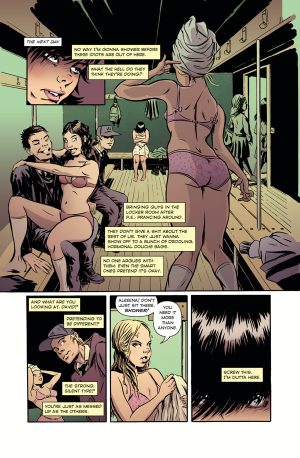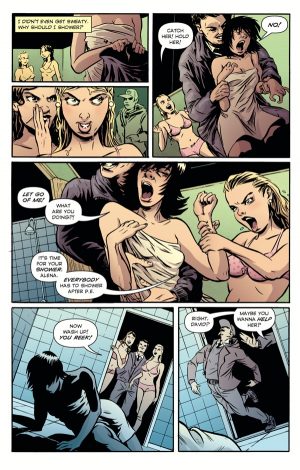Kim Andersson’s Alena really took me by surprise. Knowing as little as I do about Swedish comics and the Swedish scene, having this incredibly nuanced and disturbing horror story seemingly burst on the scene really stuck with me. I chatted with Kim Andersson about Alena, making comics in Sweden, and his upcoming book for Dark Horse, Astrid. Kim is going to be at New York Comic-Con. You can view his Facebook group here https://www.facebook.com/kimwanderssoncomics.
 Zeb Larson: Tell me a bit about making comics in Sweden. I have to confess that I’m very unfamiliar with the scene.
Zeb Larson: Tell me a bit about making comics in Sweden. I have to confess that I’m very unfamiliar with the scene.
Kim Andersson: Funny thing about Swedish comic scene is that it is more women than men…dun dun dun (laughs). At least 50/50, but it could be more women than men. The alternative scene in Sweden really exploded, and the feminist comics got really big in Sweden, like outside the comics scene. It got high-brow cultural attention. Some of those creators have made a place for themselves that way. It started out punk, it still looks punk, but the highbrow cultural establishment likes that.
ZL: That’s pretty different from this country.
KA: Yeah it is, isn’t it. What you would consider alternative comics, black and white, a bit more crudely drawn, is the mainstream. What I do, is like genre comics, a lot of horror and now sci-fi, that is the alternative. The superhero comics scene… I don’t think there is one in Sweden. Marvel and DC are just film studios. Swedes all speak English; if you’re a comic book nerd, you read American comics. And superheroes are such an American thing…
ZL: Where did Alena come from?
KA: The book came out of a bunch of comics in a monthly comic book magazine called NEMI and every issue I did like a short comic called Love Hurts. I had done them for a few years, I had mad one collection, one book, and it was time for my new to level up and have a new challenge, a graphic novel. Through that comic book, I had gathered a bit of a following of readers, and they were almost exclusively teenage girls. Goth and emo teenage girls. The best kind of fans you can have: so cool, so dedicated. I’ve always done exactly the kind of comics I want to read, so I guess I’m a goth girl at heart.
(Laughs)
 I wanted to make a graphic novel, and I wanted to make something for my fans. Not that I owed them, but I liked them, and I wanted to give them something more than a dark humor, scary comic, but a proper piece of work. So I worked on it for years, several years, like with my left hand, and finally, I decided to start, and it was published in this magazine called NEMI, serialized in eight episodes. And then it came out as a book, in 2012 I think. I remember the first review I got from it, a Swedish comic blog, and the headline was “Lesbian horror comic.” I mean, I guess it could be about that? I was more into the idea of a queer idea of their sexuality being more fluid.
I wanted to make a graphic novel, and I wanted to make something for my fans. Not that I owed them, but I liked them, and I wanted to give them something more than a dark humor, scary comic, but a proper piece of work. So I worked on it for years, several years, like with my left hand, and finally, I decided to start, and it was published in this magazine called NEMI, serialized in eight episodes. And then it came out as a book, in 2012 I think. I remember the first review I got from it, a Swedish comic blog, and the headline was “Lesbian horror comic.” I mean, I guess it could be about that? I was more into the idea of a queer idea of their sexuality being more fluid.
All of these characters are me, of course. I’ve been asked why I always draw female characters. I have several answers, but one of them is that it’s easy to hide behind. This is a story about young people, and young boys aren’t allowed to show their emotions. If I want to write about feelings, it’s easier to do it as a girl. In my head, I put on a skirt, and I can declare my emotions in another way.
The different characters in Alena… I actually kind of fell in love with the villain. It’s not that uncommon as a writer. Your villain tends to be the more interesting character. I like how she turned out, and I like how she turned out in the movie. I think that’s the hardest part in the movie.
ZL: Your view of adolescence seems to be dark, at best. Were your teenage years' anything like this?
KA: Everyone has some hard experiences growing up. It’s not easy for anyone; you try things, and things happen to you for the first time, and everything is very dramatic and high-stakes. I wasn’t bullied myself, not regularly, but I had some experiences of feeling bullied or being bullied. Everyone can relate to being bullied; it’s very common, unfortunately. It’s inspired by my life, but it’s inspired by my thoughts and ideas of growing more than personal experience.
But actually, there’s one scene in the book and the movie as well, and that’s the shower scene… it’s rapey. I shouldn’t sugarcoat it; it’s rape. And that comes from a personal experience. It wasn’t in the script at first; I just needed it in an otherwise boring chapter of the book. I told my colleague this story about when I was growing up, and we were like a gang, and in my gang, there were these girls who were so fucking mean, and they ruled the school and their class. They invited me and a friend of mine to watch them get dressed after PE, and I guess they were confident and wanted to show off their bodies. All the other girls in that class had to just accept it; they couldn’t do anything. We just sat there like teenage boys thinking this is the coolest, but that experience stuck with me, and as I got older I started thinking about all the other people in that room and how they experienced that situation, and why those girls invited us. The whole rape thing wasn’t there, but it comes from that personal experience. I think that people can find themselves in that situation, but can’t explain it, so that’s why I put it in the comic: to try and understand why they did this, and why I didn't do anything to stop it. Even if the book contains all of this violence, that’s the scene that affects people the most. Your brain starts to run away from you when you read it. I’m not very interested in doing it again, and I felt like, “Wow, this is a really sad person who wrote this book.” It was very important for me to write it, and I worked through a lot of stuff writing, and I’m very happy I did, and now I don’t have to do it again.
 ZL: Let’s talk about the influences of Alena for a built. I picked up overtones of Stephen King pretty strongly, but madness seemed to be at the root of all of this as well. What past stories were important to you as you were writing this book?
ZL: Let’s talk about the influences of Alena for a built. I picked up overtones of Stephen King pretty strongly, but madness seemed to be at the root of all of this as well. What past stories were important to you as you were writing this book?
KA: Carrie was the big one. I haven’t actually read the book, but I’ve seen the movie a hundred times. It’s almost an embarrassingly big influence on this book. Definitely Stephen King, that one is really big for me. And I was interested in the whole Tyler Durden Fight Club idea way of telling a story. As far as comic books, I’m a huge fan of the Jaime Hernandez; he’s a big influence of mine and got me back into comics. Love and Rockets are absolutely fantastic. It is very film-ic, the storytelling is like a movie. I grew up on horror movies, I’ve seen them all. This one summer when I was 14, we borrowed horror movies from a friend’s older brother, and for one summer, we saw them all. So, I saw them all, well, before 1993, but I guess they all got lodged in my head.
I’ve never thought about this, but I’d done a bunch of horror, and maybe Alena was the one to cap it all off.
ZL: So does all of that exposure to horror sort of explain the tension between insanity as one explanation and the supernatural as another in Alena?
KA: Pretty much, yeah. It was pretty much that mix of horror influences. I tried to cram a lot of stuff into those pages, and I wanted to move through sub-genres of horror, raise questions about whether she was pushed off the bridge or jumped off the bridge.
ZL: I want to talk about the art, which I thought was really strong for this series. The way you frame some of the characters’ faces is powerful because every sneer and grimace seems so exaggerated. How intentional was that?
KA: When I got to France, all the French say “all your comics are very American.” And in a way they are, I grew up on American comics; when I talk to American audiences and creators, they saw that what I do is European. There’s something I find in European comics that I like: they’re very good with expression. Whereas American comics, this might be a bit mean, but they can be very stiff. I think a lot of American comic book art is aiming for realism, and somewhere on the way to realism, they have to stop. It would take forever to draw it otherwise, but I’m not aiming for realism; I’m trying to go in another direction. More expressive than reality.
 There’s always been this discussion around comics; why do they look so ridiculous? Especially the women; they have super-thin waists and big boobs, and the creators says “It’s exaggerated, we want to make the story read more easily.” I agree with that idea, but you should exaggerate everything. If it’s a teenager, you exaggerate the teenage-ness of him or her.
There’s always been this discussion around comics; why do they look so ridiculous? Especially the women; they have super-thin waists and big boobs, and the creators says “It’s exaggerated, we want to make the story read more easily.” I agree with that idea, but you should exaggerate everything. If it’s a teenager, you exaggerate the teenage-ness of him or her.
ZL: How closely involved were you in the film adaptation?
KA: I was very close to the production. So these guys that the made the movie, the producer, and the director, they’re friends of mine because we work in the same field. We’re kind of a gang, so there’s me, another comic book artist, a couple of authors, they wrote this trilogy of urban fantasy books, the first one is The Circle, The Fire, and The Key. We’re this group of different creators: artists and writers and creators, and we work in each other’s projects. When they made a movie of the Circle, I got to draw design stuff for that movie.
I got to be involved from day one. I didn’t get paid for it, but I wanted to do it. You’ve read about all of these authors who sell their rights and end up buying a ticket to see what was their story? I instead got to work on costumes and locations and scriptwriting. Me and the director made a lot of changes, or the director made a lot of changes, and I got to okay everything. I don’t think I turned down any ideas, though; I was excited to see this updated version of the story. As soon as they started shooting, I kind of stepped back. I’d done my part; I don’t want to be hanging over Daniel DiGrado’s shoulder. It was up to him to make his vision of the story. I do a little cameo.
Now I’m really hoping it goes to Netflix. Netflix is a really good tool for exposing international media, especially to American audiences. Everything is mixed; Swedish movies aren’t in their own genre, which I think makes it more likely people will check them out.
ZL: Can you tell us at all about Astrid and what it’s going to be like? Is it going to be a point of departure from slasher stories?
 KA: I just finished the book. It took quite a while to make. This is the next challenge; I try to make a new challenge for every book, to create a comic book character I can make several books with. The first book took a long time to make, because I had to write her universe, but then I finally started drawing, color, and inking it, and that was reasonably quick. I started drawing completely digitally for this book, and that was a new challenge as well. You want to work digitally to save time, but you have to learn how to do so, and it takes time. The screen I’m drawing on is just another time.
KA: I just finished the book. It took quite a while to make. This is the next challenge; I try to make a new challenge for every book, to create a comic book character I can make several books with. The first book took a long time to make, because I had to write her universe, but then I finally started drawing, color, and inking it, and that was reasonably quick. I started drawing completely digitally for this book, and that was a new challenge as well. You want to work digitally to save time, but you have to learn how to do so, and it takes time. The screen I’m drawing on is just another time.
I sent it off to Dark Horse a couple of weeks ago, and I’m really proud of it. I wanted to make an adventure like Indiana Jones or that kind of adventure, but where things had consequences. When things happen, people in my story, I want them to feel it and not to forget it in the next scene. I wanted to give them a fantastical adventure in space, on different planets and with aliens, but I want it to matter what they go through and not just be random twists of the plot. They take it with them.
It’s a weird thing make these. I’m an author, which takes forever, and that sucks, but it gives you the opportunity to do exactly the way you want to. Sometimes you can’t, and capturing a feeling on paper can be hard, but I have this idea that the blessing of being an author is that as long as everything comes from you, it’s right. It’s what should be in the story. When you make a story with another person, then there has to be a vision that everyone shares. When a director makes a movie, he makes a vision and has to get everyone on board. When I make a comic as an author, the vision doesn’t have to be clear, and as long as I’m true to myself, it’ll work out. I’m a firm believer in this Joseph Campbell a hero with a thousand faces, and that everyone has the legos to create a story inside them. As long as I follow my heart, it’ll be good.
ZL: And when can we expect to see it in America?
KA: Astrid volume one, Cult of the Volcanic Moon, it’s gonna come out the 30th of November. I’m doing a small print run in Sweden as well and doing a Kickstarter for that, but I made the book for Dark Horse. It’s the third book of mine, but the first I wrote specially for them. I’m looking forward to the next one with them, and that’s what I want to do with them going forward with Astrid. It’s sort of a weird blessing that we don’t make any money; as Becky Cloonan put it, everybody who is working in this is here because they love it, not because it’s a way to make a mortgage. Making a comic with pen and paper can make something as big as I want; I could theoretically create Star Wars, and no one could tell me that my Yoda wouldn’t be 200 meters tall.
